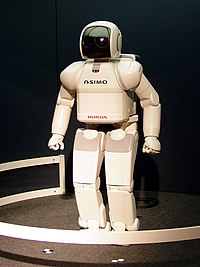
Photo from wikipedia
Abstract This paper presents the self-motion conditions of the 3- PP PS parallel robot with an equilateral mobile platform and an equilateral-shaped base. The study of the direct kinematic model… Click to show full abstract
Abstract This paper presents the self-motion conditions of the 3- PP PS parallel robot with an equilateral mobile platform and an equilateral-shaped base. The study of the direct kinematic model shows that this robot admits self-motion of the Cardanic type as the 3- R PR planar parallel robot where the first revolute joint of each leg is actuated or the PamINSA parallel robot. This property explains why the direct kinematic model admits an infinite number of solutions in the center of the workspace but has never been studied until now. The condition of this singularity is described and the location of the self-motion in the workspace with respect to all the singularities is then presented. The quaternion parameters are used to represent the singularity surfaces and the self-motion conditions in the workspace.
Journal Title: Mechanism and Machine Theory
Year Published: 2019
Link to full text (if available)
Share on Social Media: Sign Up to like & get
recommendations!